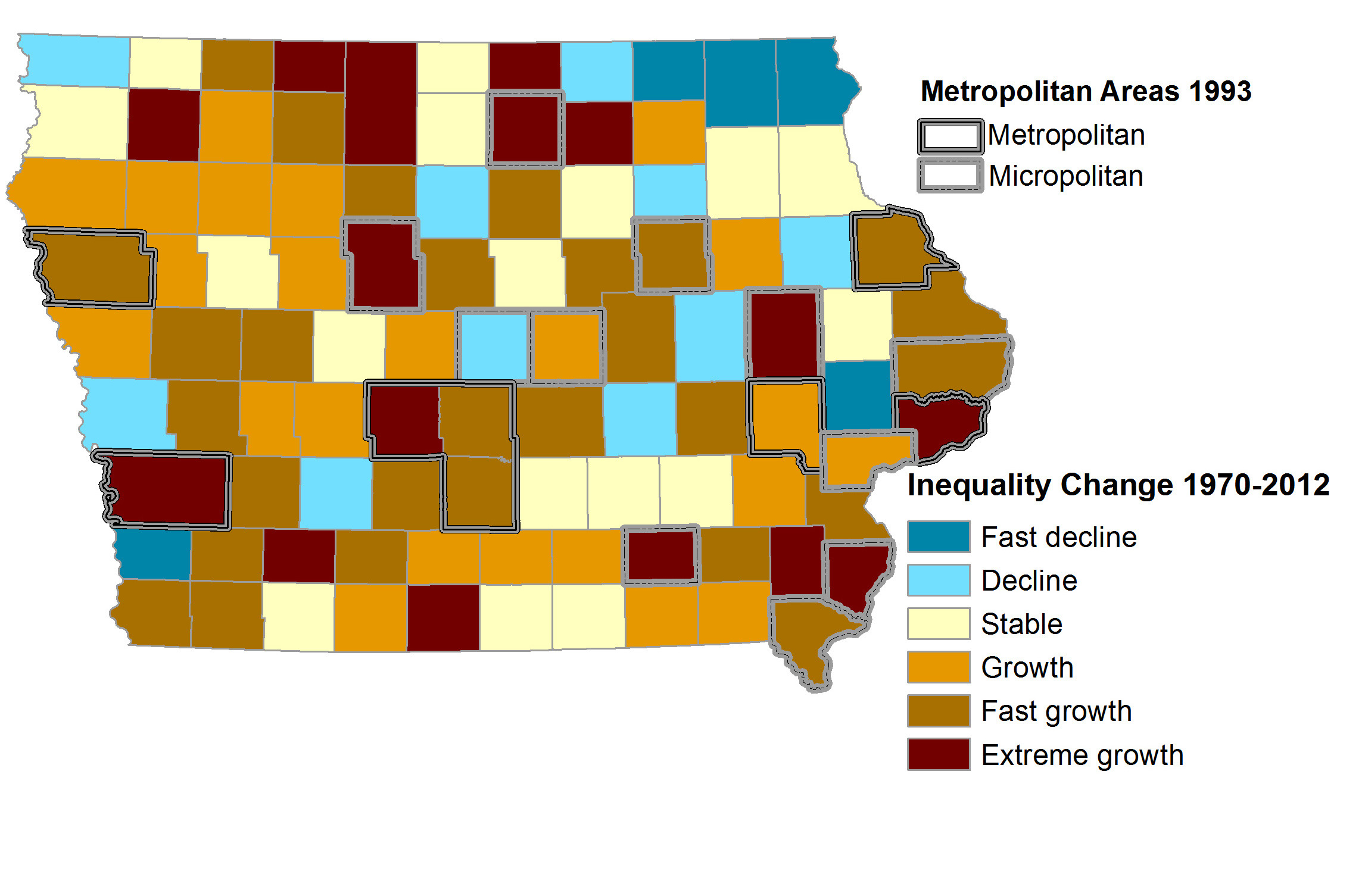
This map shows how the rate of income inequality has changed in each Iowa county from 1970-2012. (Larger image) Courtesy David Peters
AMES, Iowa – Job growth in the retail and service sector has not matched the wages of manufacturing and other middle-skill level jobs lost over the past decade in Iowa. The difference has contributed to a growing disparity between low and high income households, which is especially profound in specific parts of the state, according to a new report by Iowa State University Extension and Outreach rural sociologist David Peters.
Inequality in Iowa is below the national average, but the rate of polarization has outpaced the national level. Peters analyzed 40 years of data from the U.S. Census Bureau to identify trends in income distribution and the potential impact on Iowa. During that time frame, inequality grew faster in metropolitan areas and smaller cities, which is largely driven by growth in low-wage service positions in contrast to high-end professional and financial service jobs.
“The bottom earners have really taken a hit, especially since the last recession, and that’s what is driving inequality,” Peters said. “The wage replacement for people who are laid off from middle-skilled, middle-wage jobs is much lower. They’re not able to recoup those wages and that’s where you see falling incomes.”
The disparity in wages is also evident in rural parts of the state. In the 2000s, the growth pattern changed and inequality grew faster in rural Iowa than metropolitan Iowa. Peters points to growth in farm income, due to higher commodity prices, as a main factor. This is especially true in northwest Iowa, where farm income along with amenity attractions such as the Iowa Great Lakes, has increased the concentration of wealth. However, Peters expects inequality in rural areas to even out as commodity prices have dropped from record highs.
Reversing the trend
Income distributions had been relatively equal in Iowa in the past. The shift to more extreme highs and lows could bring negative consequences unless policymakers take action, Peters said. Attracting high-skilled and high-wage jobs to the state is important, but middle-skilled and middle-wage positions are just as critical. Peters said state leaders should utilize tax and economic incentives to recruit employers to fill that gap.
“Anything policymakers can do to increase wages, incomes and job opportunities, for low-to-moderate-income workers, is really going to help minimize inequality,” Peters said. “It’s not building new retail, it’s recruiting jobs that pay a decent wage and have some benefits, and that target middle-skilled workers.”
There is also a cultural impact associated with the loss of middle-level jobs. Iowa is still a great place of economic mobility, but less than it was in the past, Peters said. Today, there are fewer quality jobs for workers with only a high school education or some type of technical training. If this trend continues, it can lead to greater inequality and poverty. Peters said ultimately that affects the culture and work ethic in Iowa and the belief that with hard work you can get ahead.
“Where inequality really matters is when social mobility slows down. It can create a culture of not wanting to move ahead that affects career aspirations,” Peters said. “In Iowa it’s a fairly big cultural change to have extremes of wealth and it’s hard to know the implications. If we follow the trend of the rest of the country, we’re going to see more private schools, unwillingness to invest in public education, and more residential housing segregation by income.”
As part of the state’s job creation efforts, Peters recommends changes to the income and capital gains tax structure to pay for incentives to grow middle-skill, middle-wage jobs. He said the state also needs to invest in quality education that is accountable for student outcomes and provides tangible skills in the labor market. The full report is available at: http://www.soc.iastate.edu/news/PM3068.pdf.
